
This is a recipe I found in Jorge Jurado’s cookbook, Sabores de Panamá. I should tell you it isn’t a ‘traditional’ Panamanian dish, but rather an interpretation by this talented chef utilizing ingredients commonly found in Panama. His recipe called for beef shanks, but I had just picked up some short ribs and decided to use them instead. It turned out beautifully.
The intense combination of spices, together with the deep and rich color of the final dish made this reminiscent of Mexican mole. I can’t really think of a traditional Panamanian dish that is even remotely similar to mole, but this is a rocking interpretation!
Costillas Braseadas con Cafe, Chocolate y Anis Estrellado (Coffee, chocolate and anise braised short ribs)
Marinade – a day ahead
2-1/2 lbs short ribs
1/2 bottle red wine (one you would drink)
3 garlic cloves, diced
1 tbsp instant coffee
2 carrots, sliced
1 bay leaf
12 peppercorns
2 star anise pods
2 tbsps olive oil
1 tbsp salt
Combine all the ingredients in a ziploc bag and allow the ribs to marinate overnight or, at least for a few hours. Turn the ribs occasionally.

Braising – day of
1-1/2 onions, chopped
4 garlic cloves, chopped
Marinated ribs and the carrots
Extra virgin olive oil
Approx 2 cps broth (chicken/beef/veg)
1 tbsp sugar
1 oz bittersweet chocolate
Salt to taste
Remove the ribs from the marinade and pat dry with a paper towel. Meanwhile, heat a Dutch oven to medium-high and add the olive oil. Brown the dry ribs on all sides, remove from the pan and set aside.
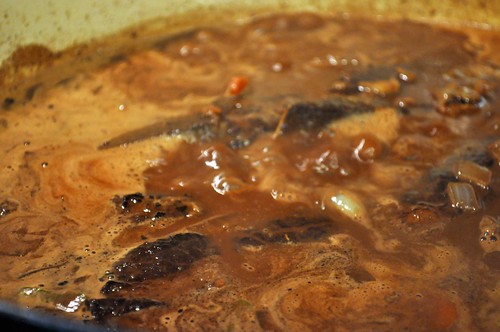
Drain the excess fat, leaving about 2 tbsp of oil/fat in the pan. Add the onions, garlic and carrots and allow to cook until they begin to caramelize. Return the ribs to the pan and add the marinade liquid, broth, sugar and chocolate.
There should be enough liquid for the ribs to be completely submerged. Bring it to a boil, then reduce the temperature to low to allow for a slow simmer. This will continue to simmer for about 2 hours, until the meat is tender and falling off the bone.

I, of course, served it over rice. I love rice, sue me! I think it would be really nice with roasted veggies too, though. For more food porn, click here.

Cookingly yours,
Anamaris
I admit it. I spend a LOT of time watching cooking shows, a lot. I’m obsessed with them, sometimes I imagine I am sitting in their kitchens having a glass of wine while they tell me about how they came up with the concept for the dish. One of my favorites is Extra Virgin, hosted by Debi Mazar (of LA Law fame) and her husband, an Italian farmer and chef she met while traveling in Italy. They’re a really cute couple and they prepare all the meals in their own quirky little kitchen. I want their kitchen.

Banner taken from CookingChannelTV.com
A few weeks ago, The Hubbz and I were watching a marathon of episodes on a Sunday afternoon, when we saw it. They made lasagna. Not just lasagna, though, Lasagne alla Bolognese. What I found out about this delicious dish is that it is less tomatoey, less cheesy, but still super creamy. Similarly to how my Mami taught me to make lasagne, the Bolognese incorporates quite a bit of Béchamel Sauce, which I’m now realizing isn’t a traditional component of a basic meat lasagne.
The Bolognese sauce consists of a slow cooked creamy ragu. In their recipe, Debi and Gabriele used a combination of beef, veal, and pork and they added pancetta to the sofrito. I decided to use lamb instead of veal and Spanish chorizo, instead of the pancetta. Traditionally, the Bolognese calls for Parmesan, in an effort to bring in my Latin roots to the table, I opted for an Argentinian Sardo cheese. Sardo is similar in flavor to Parmesan, it is made of cow’s milk and has a mellow, yet rich, and lightly salty taste.
The lasagne was intensely flavorful and rich and, yes, creamy.The Hubbz loves to cheese up his meals, and even though there was very little cheese added, his need for cheese was satisfied. The sauce needs to cook for a while, so you’ll do well to start there, maybe even the day before. I actually made it in the space of a couple of hours, maybe 3 altogether.

Lasagne alla Bolognese for the Latina’s Soul
For the sauce:
1/2 cp Spanish chorizo, cubed
5 tbsp olive oil
1 yellow onion, chopped
3 carrots, chopped
2 celery stalks, chopped
3 cloves garlic, chopped
1 lb each ground beef, pork, lamb
Salt & black pepper
1/2 tsp each nutmeg and allspice
2-3 cps red wine
3 large cans stewed tomatoes
1 cp whole milk
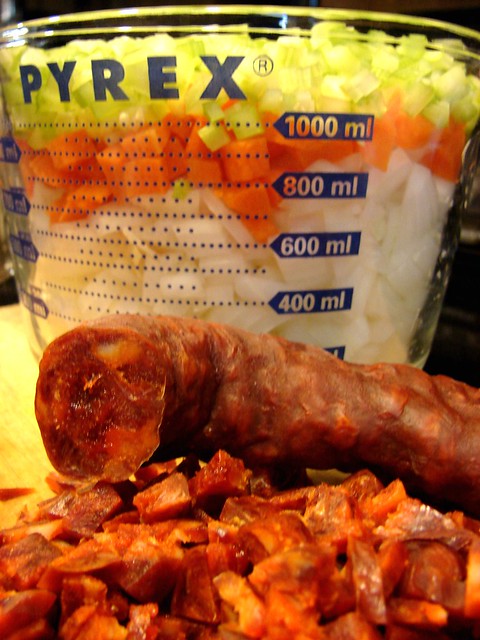
Saute the chorizo in the oil for a few minutes before adding the onion, carrots, and celery; continue cooking until the onions are translucent. Then add the meats, break it up the large pieces with a wooden spoon; once the meat begins to brown, you can add the garlic, season with salt & pepper, and the spices.

After a couple of minutes, add the wine and cook briskly for a few minutes to allow the alcohol to evaporate completely, make sure to scrape any bits that may be stuck on the bottom of the pan. In the meantime, pulse the tomatoes in a blender or food processor, then add them to the meat. Taste the sauce and season again with salt and pepper as needed. Lower the temperature to medium and cook for about 2 1/2 hours, stirring occasionally. Finish the sauce by adding the milk, stir well and set aside, to cool off. While the sauce mellows down, start working on the bechamel.
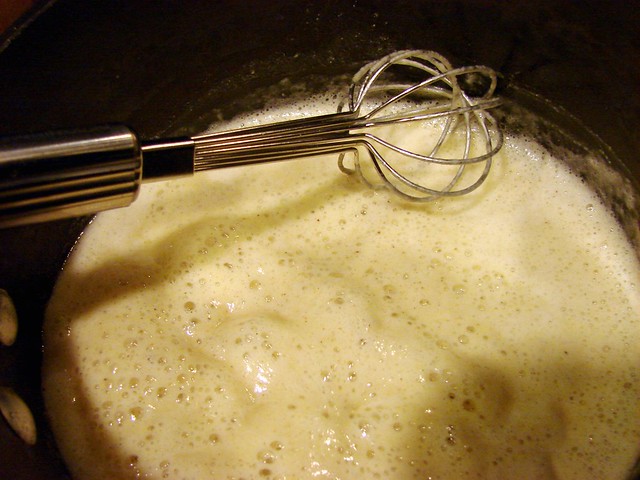
For the Bechamel sauce:
1/2 cp butter (yep, that’s a whole stick)
1/2 cp flour
4 1/2 cps whole milk
Freshly grated nutmeg
Sea salt and black pepper
Melt the butter over medium heat and briskly stir in the flour, taking care to dissolve any lumps. At this point, you want to slowly toast/cook the flour without burning it. Gradually add the milk to the flour mixture, make sure to whisk it constantly and slowly bring the mixture to a boil. Reduce the heat to low, and simmer for a few minutes, until it thickens. Season the sauce with nutmeg, salt, and pepper. Set aside to cool.
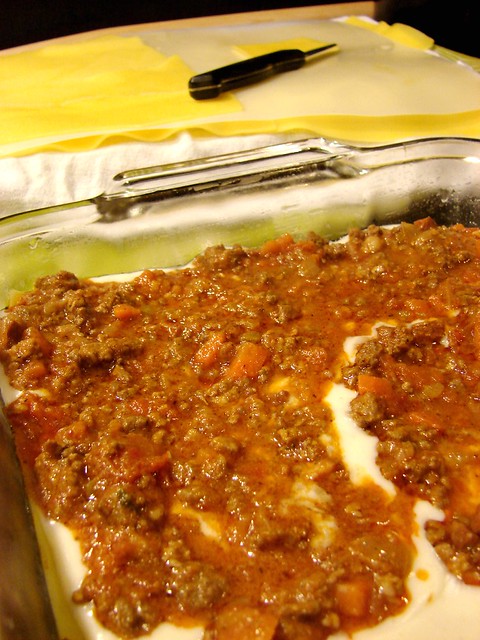
Puting it all together:
Butter
Bolognese Sauce
Lasagne noodles
Bechamel sauce
3/4 cup grated Sardo cheese
Preheat the oven to 375 degrees. Butter the pan well–I used a 9×13 pyrex–and add a very thin layer of meat sauce. Followed by a layer of noodles, then Bechamel, and finally Sardo. Repeat a couple of times. At the top, cover the noodles with meat sauce and some Bechamel, add a few thin slices of butter and finish with some Sardo.
Bake for about 30 minutes.

Are you looking for more foodie porn? Click here.
Cookingly yours,
Anamaris

Do you ever want to do so much you end up doing nothing at all? Constantly adding items to a mental to-do list that never comes to fruition? Meaning to share some wonderful experience, but never actually picking up the phone or sit before the keyboard? I hope I’m not alone in this crazy little world, but that’s where or what’s been going on with me. Work is crazy busy, they’re REALLY making me work for my money. Add to that new business responsibilities and last minute travel and you end up with a MIA blogger.
I’ve missed my times with you guys, I hope you’ve missed my updates too. Even The Hubbz finally said to me ‘Blog, baby, blog!’ Honey, this one’s for you.
I went to Portland for a bit over a week to attend a conference and I had so much good food and beer. I’ve been dying to tell you all about it, but I also wanted to share the pictures I shot of the scenery so I haven’t. Why you ask? Because I have about 600 shots to review and select the good ones before I can share them with you. That means that I haven’t finish picking, but then I haven’t posted anything else because I keep wanting to share the pictures! Do you see how this crazy cycle has been spinning? So, I decided to go back to what I promised you from day one. Food. I will talk to you about a few dishes I’ve put together in the past few weeks, a few dishes that will rock your world really hard. Promise.
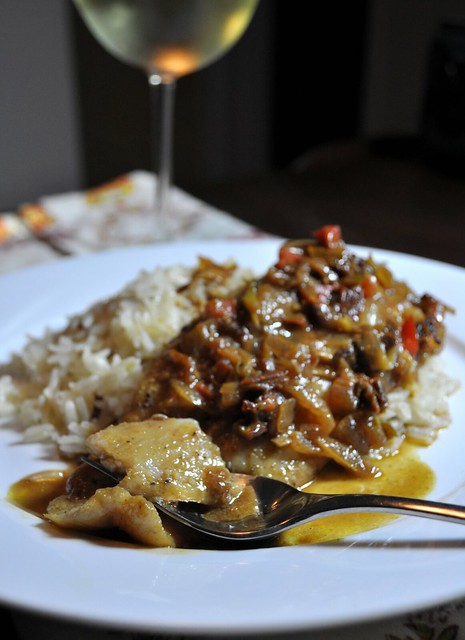
Fish. I don’t know what to call this one, but I’ll tell you how it came about. Have you heard of fish a la Veracruzana? Usually snapper. It is a Mexican recipe, hailing from the province of Veracruz. It is fish cooked in a tangy and flavorful sauce that features tomato, herbs, olives, capers and spices. I had some fillets in the freezer and started out thinking I would prepare them that way.
As the day progressed, I kept thinking about how to Caribbeanize the recipe. A bit of curry came to mind, a bit of serranos for spice. What the heck, let’s make it creamy and add a bit of coconut milk. Yep. That’s what I did, and let me tell you, The Hubbz and I ate more than we needed to AND fought over the leftovers… I won. I’m such a lucky girl! Wanna know the details? Yes you do!
Pescado a la Caribeña (Caribbean Fish)
1 lb fish fillets
2 tbsp extra virgin olive oil
1 onion, chopped
1/2 red bell pepper, chopped
1 serrano pepper, diced
2 cloves garlic, crushed
1 tomato, chopped
1/3 cp sundried tomatoes, chopped
1/2 cp sherry or white wine
1 tsp curry powder
1/4 tsp anise seeds
1/2 tsp cinnamon
1 cp coconut milk
Water
Fajita seasoning
Salt & pepper to taste
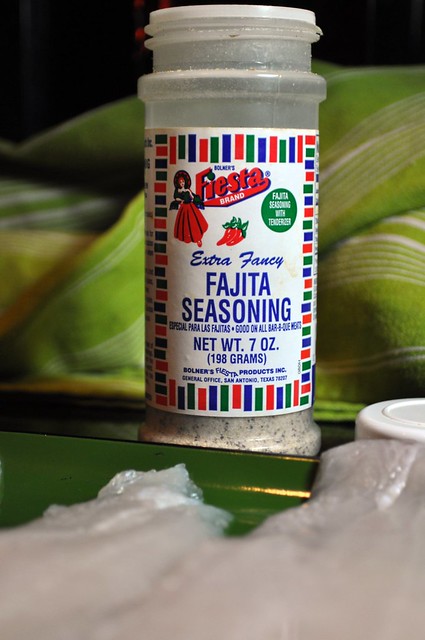
Season the fillets with a sprinkling of fajita seasoning, if not available, salt & pepper works just fine; set aside. In a large saucepan, heat up the oil and add the onions and bell pepper, cooking them until softened. Once the onions are translucent, add the serrano, garlic and continue to cook for a minute or so, just make sure the garlic doesn’t burn.
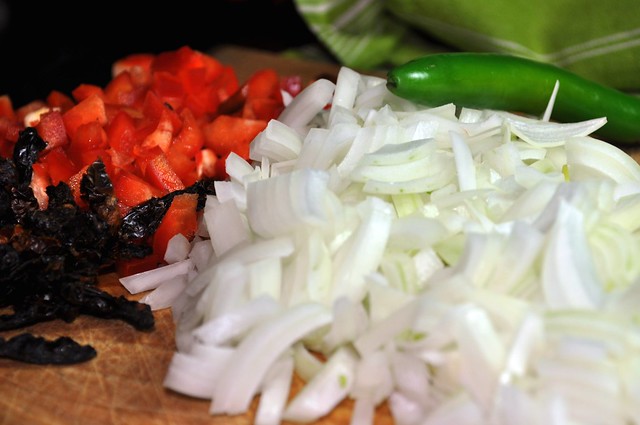
Lower the temperature to about medium and add the sundried and fresh tomatoes, curry, anise and cinnamon. Use the sherry to deglaze the pan and remove any bits that may have gotten stuck to the bottom of the pan. Allow the sherry/wine to evaporate before adding the coconut milk and water. Season as necessary.
This sauce will cook down for about 20-30 minutes to allow all the flavors to meld together, so you want enough liquid in the pan to allow the fillets to cook. I would say that by the time it cooks down you’ll want to have about 1/2-inch of liquid. I added about 1 cp of water in addition to the coconut milk.

Once this sauce cooks down, simply drop in the fillets, making sure to pour some of the sauce over each one. Cover the pan with a lid and cook the fish for about 5 minutes or until the fillets flake nicely. Serve over rice and wait until you have that first bite, YOU.WILL.NOT.BELIEVE.THE.AWESOME.
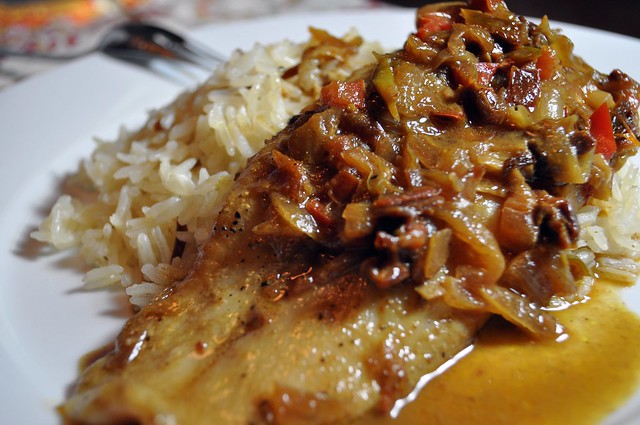
Did I mention I got a new camera? I’m still learning it, but here are a few more shots.
Cookingly yours,
Anamaris
I love learning new things, especially new cooking things. Be it techniques, flavors, ingredients, I love it. The world is so full of delicious and unique goodies, we would need to live several lifetimes in order to appreciate them all. There is a flower/plant that is very popular in Panama, the Caribbean and Mexico. In Panama and the Caribbean it is known as Saril or Red Sorrel. In Mexico, they call it Flor de Jamaica (Jamaican flower) and they use it for their aguas frescas–essentially, flavored (infused) waters.
These next 3 shots were taken by Peter, Mr. P. de Panama. A US expat living in my little country, who kindly allowed me to use his shots in exchange for the link to the recipe featuring them. I think I got the best end of that deal. Definitely take some time to visit his Flickrstream, he has some awesome photos here.
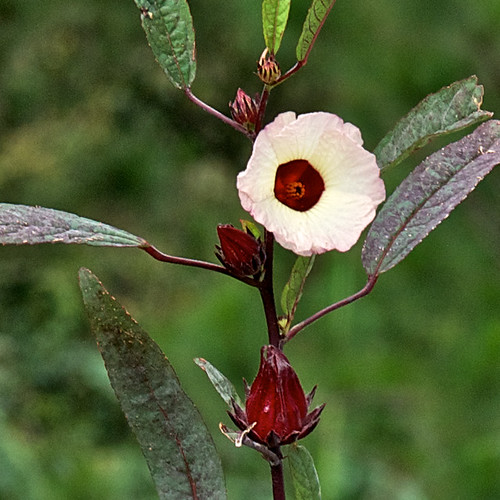
Saril bush, flower and ...the thing you make the juice with
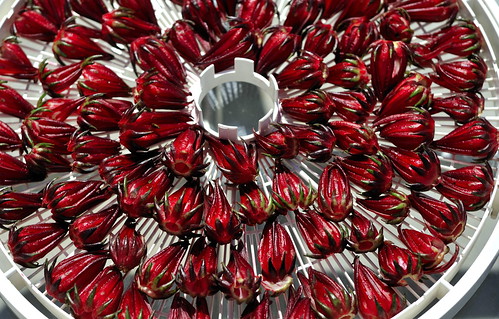
Similarly, I’ve been drinking Ponche de Saril (Saril punch) since I was a little kid; my mom and aunts would sit around for hours piting the flowers, then they would steep them with lots of ginger. To serve it, sugar and sometimes lime juice was added and then the drink is poured over lots of ice. It is one of the most beautiful and refreshing things you’ll ever drink, an awesome combination of tartness and zing. My mouth is watering just thinking about it.
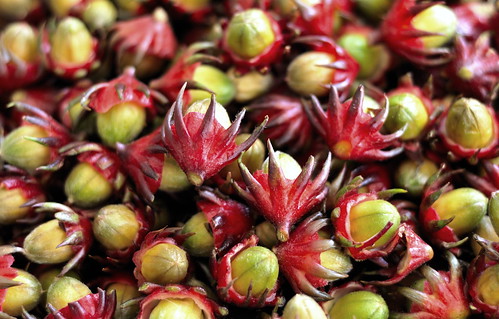
the pits!
That was the only use I was aware of for this flower, a relative of the common hibiscus plant. Recently, I read a post by one of my fave foodies, Lesley over at The Mija Chronicles. She used the reconstituted flowers to make quesadillas, then I discovered she has a fascination with the little flower and has prepared and eaten many dishes incorporating it. To say I was intrigued does not cover it. I couldn’t get it out of my mind. The possibilities seemed endless once I realized the genius of exploiting the flavors of the miracle flower. What to do…?
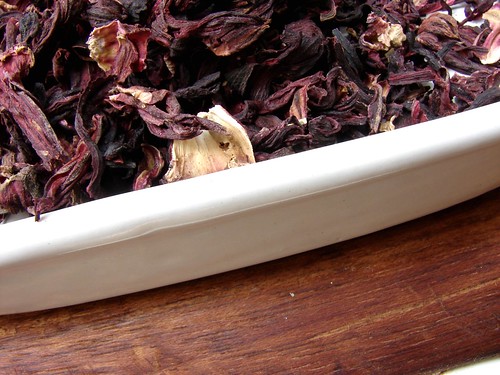
As you can see, the flower is a bright purplish red, the color intensifies when dried. The liquid, broth, tea, water, whatever we should call it, is a beautiful ruby red, a bit more intense than the color of cranberry juice. I wanted to make sure that the dish I created continued to pay homage to the vibrancy of the flower’s color. Saril’s flavor profile could be compared to that of fresh cranberries, I guess. Except, not as tart, giving way to a slight sweetness along the way. Again, I needed to preserve those flavors in the final product: chicken would open itself up to the flavors. A bit of heat and we would be golden. Want to see?
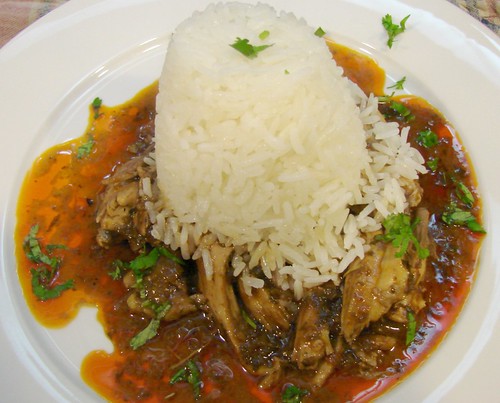
Chicken in Saril and Ancho Sauce
For the chicken
1 whole chicken, cleaned
2 carrots, halved
1/2 cilantro bunch
4 cloves garlic, whole
1 tbsp Herbs d’Provence
1 tbsp sea salt
Water
Remove the innards from the bird’s cavity and rinse the chicken under cold tap water. Place all the ingredients, except for the chicken and water in a stockpot, rest the chicken over them, then fill the pot with enough water to completely cover and submerge the chicken. Place on the stove on high heat until it comes to a boil. Once it boils, lower the temperature just enough to keep it at a slow boil (about medium-high flame) and allow it to cook for another 20 minutes.
At the end of the 20 minutes, turn off the heat and cover with a tight-fitting lid. Let it steam for another 30-45 minutes. Remove the chicken to cool and reserve the broth. This will result in the most beautiful, flavorful, moist chicken meat ever and the broth is amazing. Once the chicken has cooled, break the chicken into pieces and remove the meat from the bones into bite-size pieces. Set aside.
For the sauce
2 cps reserved broth
2 ancho chilies, whole
2/3 cp dried saril
2 tbsp raspadura or dark brown sugar
1-2 tbsp olive oil
1 yellow onion, diced
2 cloves garlic, finely chopped
1/2 cp cilantro, chopped
1 tbsp flour
1/2 cp heavy cream, approx
Reserved chicken broth
Sea salt & black pepper
Place the raspadura, anchos and saril in a small pan with about 2 cps of the chicken broth, bring it to a slow boil for about 10-15 minutes, just until the chilies have softened. Puree in the blender until smooth.
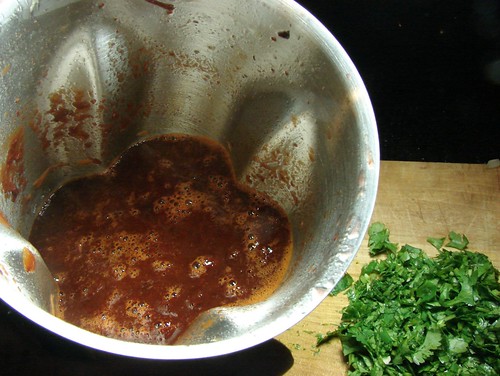
Heat a pan large enough to hold all of the chicken meat and add the olive oil, onions and garlic, cook until the onions are soft and translucent. At this point add the cilantro then the flour and stir constantly over medium heat, don’t let the flour burn, this will help thicken the sauce later. Add the saril puree and enough broth to make the sauce runny, about the consistency of half & half.

Once the sauce thickens a bit, to about the consistency of heavy cream, stir in the cream then add the chicken and lower the temperature to a slow simmer. Allow it to cook for 20-30 minutes, long enough for all the flavors to come together. Serve over white rice, maybe even pasta and be ready to be oh so happy!

To see just a few more pictures of the cooking goodness, go to my Flickr stream, here. Don’t forget to stop by Peter’s page while you’re there. Mil gracias, Pedro!!!
Cookingly yours,
Anamaris
 I made this awesome dish as my contribution to Foodalogue’s Culinary Tour as she takes us and her readers to my homeland, Panama! The criteria to participate in the tour is pretty relaxed, you can either prepare a traditional dish in a) a traditional way, b) traditional dish modernized or c) just implement local ingredients and/or techniques. This particular recipe is one of 2 I shared and it showcases local ingredients in a modern or contemporary way, the other was an almost traditional Seafood Guacho.
I made this awesome dish as my contribution to Foodalogue’s Culinary Tour as she takes us and her readers to my homeland, Panama! The criteria to participate in the tour is pretty relaxed, you can either prepare a traditional dish in a) a traditional way, b) traditional dish modernized or c) just implement local ingredients and/or techniques. This particular recipe is one of 2 I shared and it showcases local ingredients in a modern or contemporary way, the other was an almost traditional Seafood Guacho.
The recipe comes from a beautiful cookbook I picked up on my last trip to Panama. ‘Sabores de Panamá‘ (Flavors of Panama) by Jorge Jurado, one of Panama’s renown chefs who has tasked himself with bringing traditional Panamanian dishes to the next level. The recipe showcases popular local ingredients: shrimp, passion fruit, chayote squash, coconut and sugar cane, these are then elevated when combined with fish sauce and smoked paprika and a beautiful presentation.
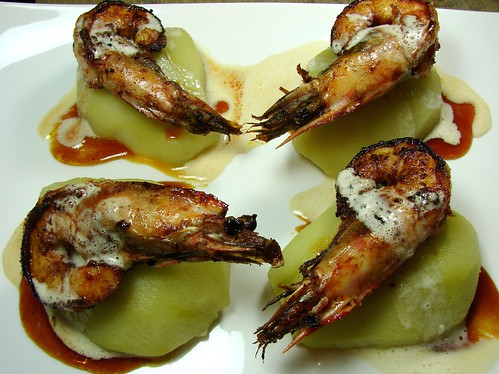
Let’s talk about the ingredients, shall we? Panama is all about the seafood, man. So much so that it is sold door-to-door. Yep, you read right. A few years ago, my dear friend Dorothy went to Panama with me and we stayed at my parents’ home. One morning while we were starting to wake up, we heard a man’s voice over a loudspeaker saying ‘Pescao, pescao, pargo, corvina, cojinoa, PESCAO’. A wave of giggles ensued, she looked at me awestruck. I had mentioned this phenomena to her, but I think she secretly doubted my honesty. See, about 3 times a week, there’s a guy in a truck who drives around my parents’ hood selling the morning catches, it doesn’t get any fresher than that. We didn’t have the ice cream truck, we get the seafood truck.
OK, back to the components of this magical dish. Chayote is a variety of squash that is as readily available in Panamá as zucchini and yellow squash is in the US. Like zucchini, it is very light, has a great deal of water content and a very mild taste with a discernible sweetness. A tart and luscious caramel made of raspadura, unrefined sugar cane, and passion fruit works beautifully with the mild flavors of the chayote and the spiciness of the smoked paprika and habanero pepper and the creamy coconut sauce. I fell in love with this dish, I think you will too.
Langostinos con Caramelo de Maracuya, Chayote y Aire de Coco (Prawns with Passion Fruit Caramel, Chayote and Coconut Foam)

For the prawns:
20 head-on large prawns, peeled & deveined
1 tbsp Spanish paprika
1 tbsp brown sugar
1 garlic clove, crushed
Sea salt & black pepper
Mix the ingredients together and use to marinate the prawns. Allow them to marinate while you prepare the rest of the components.
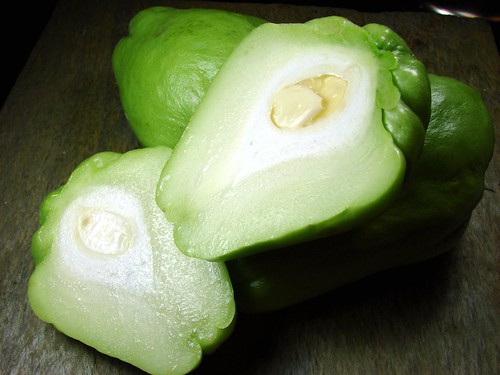
For the chayote:
4 chayote squash, halved
4 rosemary sprigs
Sea salt & black pepper
The recipe suggested peeling the chayotes and cooking in the microwave with a bit of olive oil. I don’t like handling raw chayotes, they have a sticky sap that is a pain to remove from your hands. Instead, I placed them in a pot over a steam tray, added water to the bottom, sprinkled salt & pepper over them and tucked the rosemary sprigs around them. They steamed for about 10-15 minutes and I peeled them just before serving. Easy breezy.
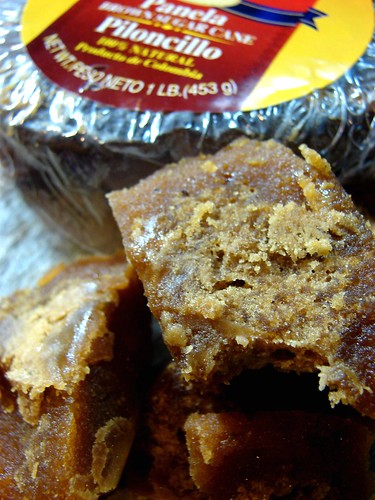
For the passion fruit caramel:
1/2 cp raspadura, crumbled
4 tbsp unsalted butter
1/2 cp passion fruit concentrate
If you cannot find raspadura, you can substitute with dark brown sugar. Melt the raspadura in a small pan and allow it to cook until it becomes caramel. Add the butter and passion fruit concentrate and cook until it thickens again, about 15 minutes. Set aside.
For the coconut foam:
1 cp unsweetened coconut milk
1 tbsp fish sauce
1 tsp fresh ginger, crushed
1/2 tsp habanero paste
1/4 tsp soy sauce
Combine all the ingredients into a small pan and bring to a boil. I didn’t end up with foam, he suggests using a hand blender, which I do not own, so I put mine into the blender. If you do own a hand blender, then keep this warm and use the blender to froth it just as you are finished plating. If you don’t, I suggest cooking down the sauce a bit, to reduce and thicken it, then you can spoon it right over the prawns.
Putting it together:
Heat a skillet and add a bit of olive oil and butter, saute the prawns, cooking for a couple of minutes on both sides (if you’re not a fan of foods with a face, feel free to remove the heads, but there is a lot of flavor there). Set aside, but keep warm.

On a plate, spread about 1 tbsp of the caramel, top with the chayote, then place a prawn atop the squash. Top witht he coconut foam or cream and be ready to ooooh and aaaah in enjoyment.
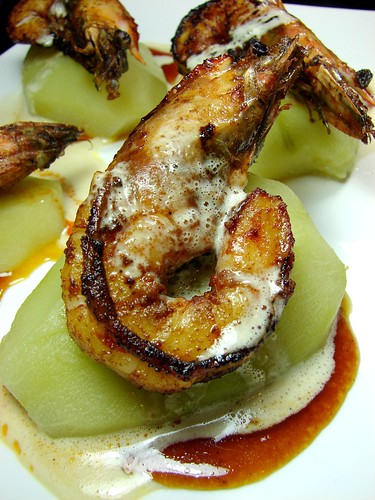
I can’t wait to make this again. Do stop by and take in Joan’s tour. For more shrimpy shots, click here and go here to see my second dish, Guacho de Mariscos y Hongos.
Cookingly yours,
Anamaris
UPDATE:
What I really want to do is bounce around with a placard yelling EXTRA! EXTRA! READ ALL ABOUT IT! But this will have to do.
Santa Marx has opened the polls for voting, so if you missed the elections, get you fix there. Click on this link to go to Marx’ post and choose your favorite use of the secret ingredients. I will tell you there are 25 fabulous entries, yes, I’m including mine. Go check’em out and vote for me your favorite one. It’s one vote per IP address, so be choosy when you imagine me spending those $200 on Marx goodies.
~~~~~~~~~~
Just before Thanksgiving madness started, I mentioned I had thrown my apron into the Iron Foodie contest hosted by Marx Foods (aka Santa Marx) and Foodie Blogroll. It was too tempting to pass it up. The challenge was set up a la Iron Chef / Chopped; we would receive mystery ingredients that we would then incorporate into an original creation.
 Let me tell you, there was all kinds of excitement at home for about a week. It all started out with the Iron Foodie contest. I had to submit the application post and wait a few days (read: eons) to learn if I had been selected. Once selected, I waited another few
Let me tell you, there was all kinds of excitement at home for about a week. It all started out with the Iron Foodie contest. I had to submit the application post and wait a few days (read: eons) to learn if I had been selected. Once selected, I waited another few eons days to receive the mystery box. We knew we would receive a total of 8 items and had to use at least 3 in the recipe.
The waiting was killing me, so in the meantime I decided to torture myself with the offerings on the Marx site. That’s when it happened. I found their blog… and another opportunity for freebies. I tell you what, I was like a crack addict. Every time I saw the UPS or FedEx or USPS trucks I would start pacing around, hoping for that hit, I mean knock on my door. And when I received all my deliveries, I yearned and longed for the knock again. OK, sorry.
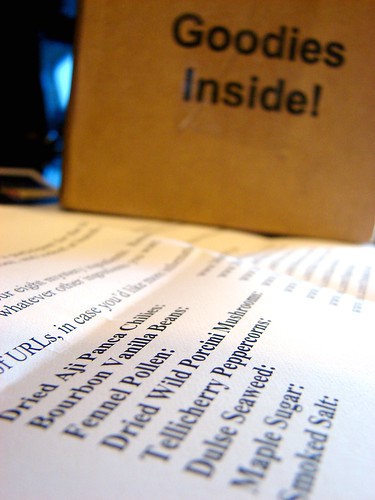
This post is about what I did with the mystery ingredients. Once I had the hot little box in hand and discovered what was in it, I went from giddy with excitement to totally freaked out in about 2.2 seconds. Some of the ingredients left me dumbfounded i.e., Dulse Seaweed???? Others, I had heard of but never tried before: Fennel Polen, Maple Sugar. At first I wanted to try making something sweet because I don’t seem to offer you enough desserts, but the sweets just don’t speak to me.
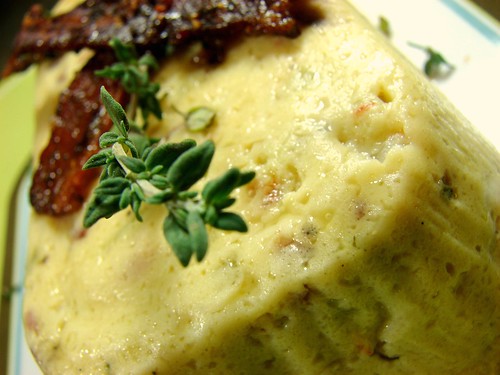
I will tell you that I made an earlier attempt which included the seaweed, chile panca, vanilla bean and peppercorns. I kept thinking about a savory flan and because the seaweed is, well, from the sea, I went with shrimp. I incorporated the maple sugar and Telicherry peppercorns in the bacon. It was good, but I should’ve made a sauce for it and, overall, I didn’t see myself making that dish ever again. Back to the drawing board I went.
I had planned on a dessert and I WILL make it in the next few days, but then I was struck by a thought or a memory or something. I love Chinese Salt & Pepper Shrimp or Calamari. I’ve never made it, but I loooooove it. So I thought, I could make that with the Smoked Salt and Tellicherry peppercorns! That’s how this came to be. Instead of deep-frying, I pan-fried. Instead of shrimp or calamari, SALMON! I finished it up with a creamy sauce incorporating the chile panca and fennel polen. YUM!
Salt & Pepper Salmon with Fennel & Panca Cream
Salmon fillets, skinless
Smoked salt
Telicherry Peppercorns
Extra virgin olive oil
1/2 cp heavy cream
1 small chile panca, finely chopped
1 tsp fennel polen
Smoked salt
Telecherry pepper
Though I love salmon skin, I chose to have it removed for this application. I started out with 2 fillets cut from the thick part of the fish, those fillets were then halved into 2-inch sections (approximately).
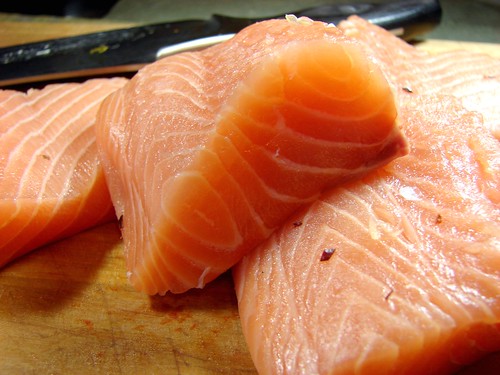
Grind the peppercorns; if you don’t have a spice grinder (like me), place them in a baggie, put the bag over a towel and use a rolling pin to break the peppercorns. Another alternative is to use a mortar and pestle. Combine about 1 tablespoon smoked salt and pepper.

Dip the salmon pieces in the salt/pepper mixture (top and bottom).
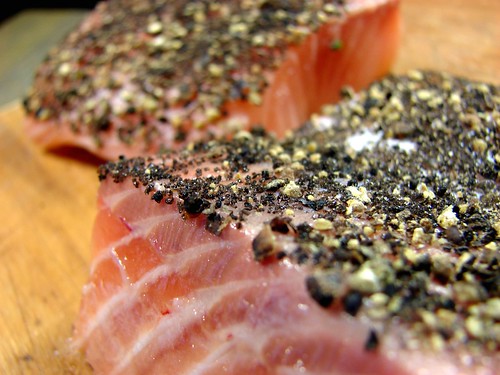
Heat a nonstick skillet over high heat, add a swirl of olive oil and sear the salmon pieces on both sides–about 2 to 3 minutes per side depending on thickness and how done you like it. Set aside and keep warm.
Rinse out the skillet, heat over medium and add a bit of olive oil. I removed the seeds from the chili before chopping, I wasn’t looking for heat, just the fruity flavor.

Add the panca chili, stirring constantly. Add the cream and fennel polen, season with smoked salt and ground pepper. Remember the salmon will be heavily seasoned, so don’t add too much salt to the sauce. Allow it to come to a soft boil for a minute or two. Run through a blender before serving.
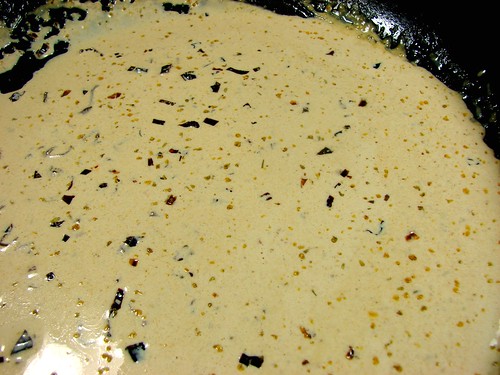
I grilled a few asparagus spears, poured the cream on the bottom of the plate, then came the asparagus and salmon over that. This salt is incredibly flavorful, the salmon tasted as though it had been smoked. And the peppercorns are strong! They really wake up your palate.
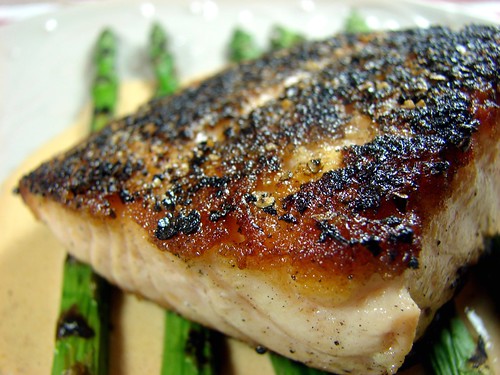
Finally, the creamy sauce brought it all together. It was silky, rich with a hint of sweetness from the fennel, but not at all overpowering. This one goes in the archives and you, you should really try it.

For more shots, click here.
Cookingly yours,
Anamaris
You can find the original recipe to this delicious mole on Rick Bayless’ site or, as I did, on this cookbook. The full version of the recipe includes all the peppers that need to be roasted, rehydrated and blended. I took a shortcut here. Instead of using the various peppers (chiles), I went for a prepared, store-bought mole under the assumption that it would include said peppers. I know. There are a few Mexican grandmothers turning in their graves as I type this. My only hope is that they don’t read English and maybe won’t understand the extent of my trespass. Move on.
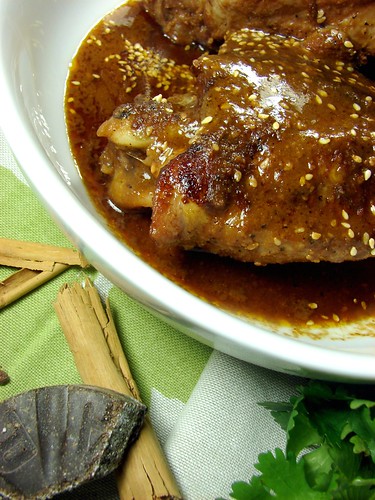
I suppose my shortcut doesn’t allow me to judge the true tastes of the original recipe, but I can tell you that shortcut or no, this recipe rocks! This stuff is so delicious, I considered bathing in it. OK, I know you don’t need that graphic ingrained to your brain. My bad. Anyway, this would be awesome on chicken, pork, seafood, coffee, cookies, eh er…

Turkey in Red Mole Sauce (adapted from Mexico – One Plate at a Time)
makes about 10-12 cups of sauce
5 medium tomatillos, husked and rinsed
1/2 cp sesame seeds
1/2 cp rich pork lard or vegetable oil (I used bacon fat)
4 garlic cloves, peeled
1/2 cp unskinned almonds
1/2 cp raisins
1/2 tsp cinnamon, (use ground Mexican canela if available)
1/4 tsp black pepper, freshly ground
1/4 tsp anise
1/8 tsp cloves
1 cp pre-packaged mole sauce
1 slice firm white bread, darkly toasted and broken into several pieces
1 oz (about 1/3 of a 3.3-ounce tablet) Mexican chocolate, roughly chopped
Salt
4 – 5 tbsp sugar
4 turkey thighs with skin & bones (approx 4lbs)
And now, for the steps:
Roast the tomatillos under a very hot broiler until splotchy black and thoroughly soft, about 5 minutes per side. Scrape into a large bowl.

In a dry skillet over medium heat, toast the sesame seeds, stirring nearly constantly, until golden, about 5 minutes. Scrape half of them in with the tomatillos. Reserve the remainder for sprinkling on the turkey.
In a heavy-bottom pot or dutch over or Mexican cazuela, if you have one of those, heat the bacon fat over medium heat and fry the garlic and almonds, stirring regularly, until browned (the garlic should be soft), about 5 minutes. With a slotted spoon, remove to the tomatillo bowl, draining as much fat as possible back into the pot.
Add the raisins to the hot pot. Stir for 20 or 30 seconds, until they’ve puffed and browned slightly. Scoop them out, draining as much fat as possible back into the pot, and add to the tomatillos. Set the pan aside off the heat.

To the tomatillo mixture, add the cinnamon, black pepper, anise, cloves, bread, mole sauce and chocolate. Add 2 cups water and stir to combine.
In two batches, blend the tomatillo mixture as smoothly as possible (you may need an extra 1/2 cup water to keep everything moving through the blades), then strain it into a bowl and set aside.
If you’re using uncooked turkey, this is when you will season the turkey with salt & pepper. Raise the temperature on the pan to medium-high and brown the thighs on all sides, this will take about 10 minutes. If you make the mole sauce ahead, you can move on to braising the thighs in the sauce. If you are still working on the sauce, go ahead and put the turkey in the fridge while the sauce gets ready.
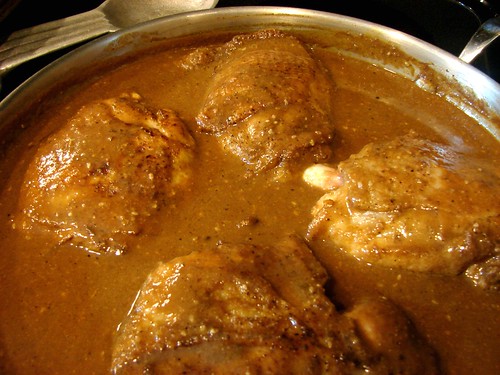
Pour out any excess fat, you only need enough to leave a film on the bottom of the pan. Add the blended tomatillo mixture and cook, stirring every few minutes until considerably darker and thicker, 15 to 20 minutes. You’re looking for the sauce to become the consistency of tomato paste. A word to the wise, use a spatter screen, this mole business is very spitty.
Add 6 cups of water to the pot and briskly simmer the mixture over medium to medium-low heat for 45 minutes for all the flavors to come together and mellow. If the mole has thickened beyond the consistency of a cream soup, stir in a little water. Taste and season with salt and sugar.
Heat the oven to 325°. Lay the turkey in the mole, cover with a lid or foil and place in the oven. Cook until the thighs internal temperature registers 150, this will take about 40-55 minutes. Remove the turkey from the sauce and allow it to rest for a few minutes. Serve with generous amounts of mole sauce.
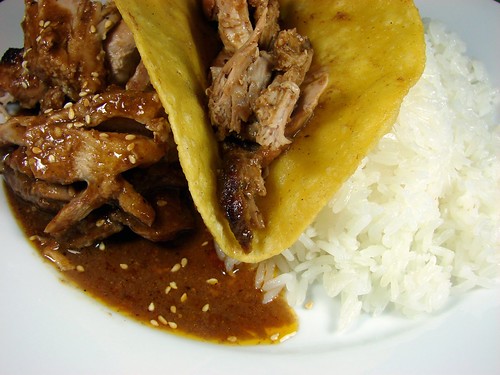
Check out the green mole here and for the rest of the mole porn shots, click here.
Cookingly yours,
Anamaris
I told you before I would make a pre-turkey day dinner for your benefit, but I lied. Don’t get me wrong, you do benefit from this, but I didn’t make this dinner just because of you. The truth is, I love turkey and would eat it year-round, so when this time of the year comes and the turkeys are plentiful… I eat and eat and, well, eat.
So, I set out to put together a Thanksgiving meal that spoke to my Latin roots while still honoring the traditional ingredients. With a little push from The Hubbz and an abandonment of safety nets, I came with what I believe is an incredible menu.

yep, that's the beginning of the menu
Pay attention, this is where you benefit: I’m about to share all of it with you! The menu. The thought process. The planning. The execution. I’m sharing it all with you in the hopes that you’ll be encouraged to recreate one or more of the dishes or that you’ll through caution to the wind and try something you’ve been thinking about for while.
The Thought Process:
Cocktails: I didn’t want anything too heavy or pumpkiny, but I still wanted to keep Thanksgiving colors in mind. I knew it needed to be spicy/flavorful.
Appetizer: I went for a soup, but wanted to keep it light while flavorful and I wanted to work sweet potatoes in the menu.
Turkey: Moist is always my first priority, so I knew I would brine it. I wanted to pick up on subtle Latin flavors without fussing too much over the bird.
Gravy: It’s like the chicken & the egg. Can’t have one without the other.
Accompanientment: Usually cranberry and, I’m sorry but I have to admit I love the canned stuff, but I needed to kick up a notch. I immediately thought guayaba! Or guava as its known stateside.
Dressing: Cornbread dressing is my absolute favorite even if traditional. My thoughts were to have corn patties topped with the extras usually found in dressing. I wanted to recreate a sophisticated version of a Panamanian tortilla.
Vegetables: Indispensable, and these pickled ones help cut through the heavy meal.
Dessert: A traditional dessert found at weddings in Panama. This is pumpkin brought to Jimmy Choo levels.
The Menu
Apricot Gingersnap Cocktail
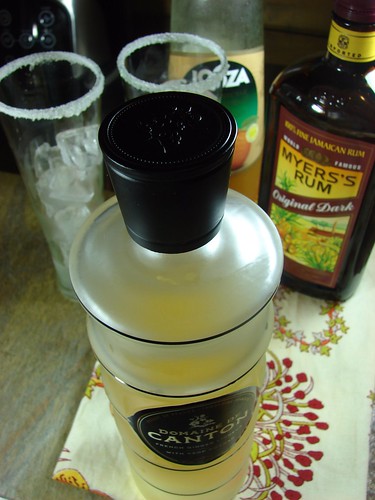
Sweet Potato Cream with Chorizo Garnish
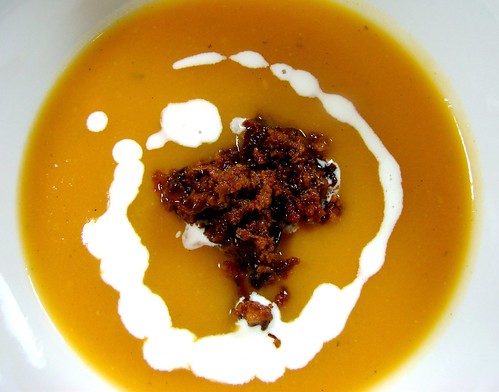
Achiote & Herbs Turkey
-Garlic Butter Gravy
-Guayaba Compote
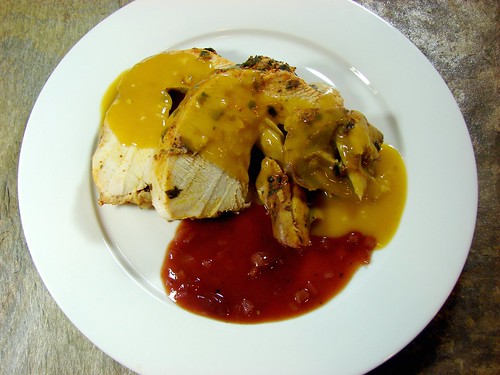
Polenta Tortillas with Sausage & Chicharron Picadillo

Green Bean & Carrots Escabeche
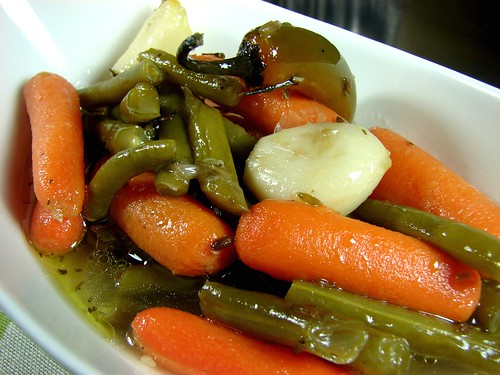
Pumpkin Sopa de Gloria

The Planning
Putting a big meal together, particularly when you have to stick to a schedule or a set dinnertime can be overwhelming. Lists make it easier. It doesn’t matter what type of project I’m working on, a list always makes me feel at ease, like I can get it done. When I just think of the big picture or the end product I can’t help but feel a bit of anxiety, like I’m going to forget something or that I don’t have enough time to finish. Lists are good. Lists are your friend.
After I had finalized the menu, I wrote down each dish and broke it down by steps. I then prioritized the order in which to execute each step.
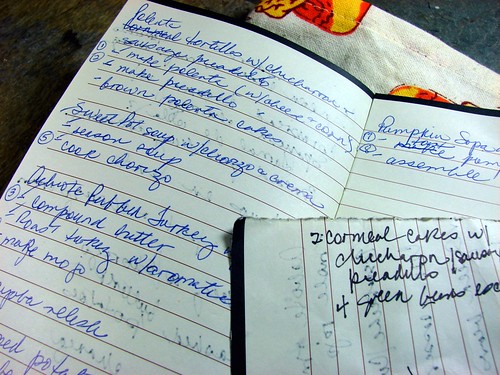
pardon my handwriting...
The Execution - for the recipes, click on the links.
Gobble, gobble!
Cookingly yours,
Anamaris
Panamá, being the proverbial melting pot, has an incredibly abundant Chinese presence. You can’t walk more than a few yards before stumbling into a Chinese restaurant or a corner tienda, a little neighborhood store where you can buy everything from fresh bread to pigs feet and a hammer. That means Chinese food has been influenced by the local’s taste buds and available produce. Chinese food in Panama is completely different from Chinese food in Houston and Houston’s is nothing like Chinese food in NYC. Adaptability. I often wonder if I would enjoy Chinese food in China. But I digress.
I’ve shared with you a recipe for roast chicken very popular in Latin America. This is pretty much the same thing with a few changes and the addition of this ketchupy sauce added to chicken in Panamá. I don’t know what it is about this simple sauce, but it would probably fall under the Chino-Latino category. Almost every Chinese restaurant in Panama will offer some version of this rotisserie chicken and BBQ pork, which is absolutely divine.
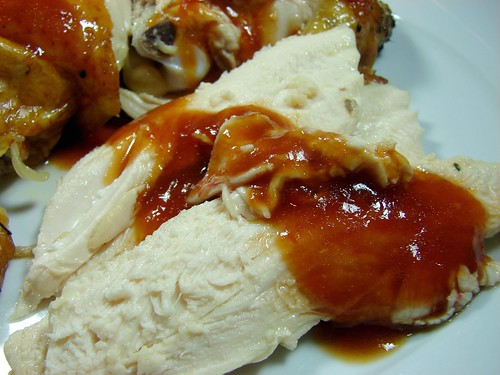
The chicken is seasoned pretty much the same, then roasted to golden perfection and served with the yummy sauce all over it. To ensure the chicken is super juicy, I brined it for just over an hour, ideally, I would’ve allowed it to brine longer, but it was still delicious. It occurs to me that this would also work brilliantly with turkey, I may just give it a try. Here’s what you’re looking for.
Pollo Panamá
1 whole chicken, approx 4-6 lbs
For the brine:
2 Sazón packets
4 garlic cloves, crushed
4 tbsp soy sauce
2 tsp sea salt
2 tbsp Italian seasoning
2 tbsp sugar
Water
Chino-Latino Ketchup
1/2 cp ketchup
1-1/2 tbsp soy sauce
1-2 tsp sugar
1/4 cp water
Habanero hot sauce, to taste
1 garlic clove, halved
2 tsp extra virgin olive oil
For the chicken: Heat about 1/2 cp of water and add the garlic, salt, Italian seasoning and sugar for the brine, allow it to come to a quick boil, then turn off and transfer to a bowl large enough to submerge the chicken. Or you can use a large ziploc bag. Give it just a couple of minutes to cool, then add the rest of the brine ingredients.
In the meantime, remove the giblets from the chicken’s cavity and rinse the chicken under cool water. Drain and place the chicken in the bowl with the brine concentrate and fill the bowl with enough water to submerge the chicken. Allow the chicken to marinate in the brine for about an hour, longer if you have the time.

Preheat oven to 350°. Prepare a roasting pan and rack large enough to hold the chicken. Drain the chicken and pat it dry. Rub it with extra virgin olive oil and place on the rack breast side down. I prefer to roast whole chickens and turkeys with the breast down to make sure it is juicy, since breast isn’t my favorite meat. If you’d rather have pretty skin on the breast, then roast it breast side up. Place the chicken in the preheated oven and allow it to roast for about 20 minutes per pound, for a 5-pounder, you’re looking at just under 2 hours.
Note: I will usually roast the chicken or turkey at 375° for about 10 minutes, then lower the temperature to 350° for the remainder of the roasting time, but I was being very lazy with this chickie. You know what? It was still perfect!
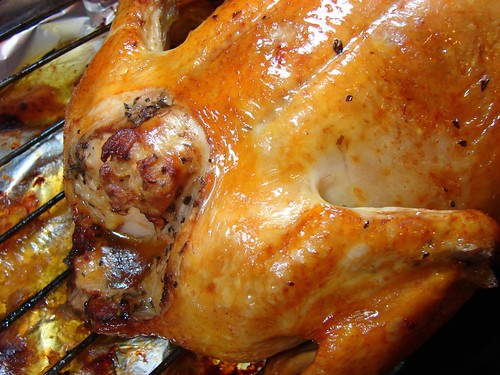
Once the internal temperature reads somewhere around 180°-185°, remove the chicken from the oven and cover loosely with foil. Allow it to rest to allow the juices to redistribute and make Ms. Chickie very happy. This is a good time to put the sauce together if you haven’t already.
In a small saucepan, heat a bit of olive oil and add the garlic halves allowing them to permeate the oil for a minute or two. Add the rest of the ingredients, tasting it after the first teaspoon of sugar, this should be to your taste. Adjust the seasoning with salt, if necessary, but the soy should take care of it. Bring it to a slow simmer for 5 minutes or so, keep it warm and spoon over the chicken to plate.
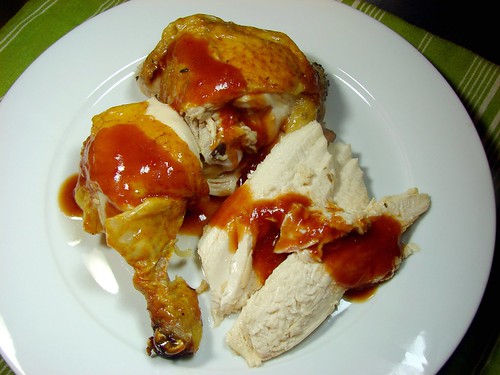
Check out the photo set for more juicy shots.
Cookingly yours,
Anamaris

Summer is the time when people start thinking about firing up their grills. When you have block BBQs. When you picnic. Depending on where you live, Summer may be on its way out. For me, living in Hell’s Waiting Room aka Houston, TX, Summer is still in full swing and will be for another 3 months or so. No kidding.
The Hubbz is in charge of the grill in our family. That’s because I’m unwilling to stand in the heat and then take on the heat and smoke from the grill. I don’t enjoy smelling like hickory or maple or any kind of smoke, for that matter. So he does it because he loves, but mostly because he loves grilling. And since I love him, I try to keep him from the grill while Hell’s Waiting Room is in the triple digit range.
I’ve rambled on. Heat does that to my brain. So do delicious, falling-off the bone, tangy sweet pork spareribs. Yep. That’s what this is all about. Pork. Isn’t that what it’s always about? I’ve shared other recipes for spareribs: oven-q’d and tamarind glazed. This time we’re talking grilled and basted with my Dad’s secret recipe. It won’t be secret after this post, sorry Dad.
Spareribs tend to have more meat and fat than baby back ribs, they’re also not as tender but they ARE much less expensive than the skinny little baby ribs. Besides, who wants to be accused of eating baby parts? I say, if you’ve not tried spareribs, give them a chance.
Dad’s BBQ Spareribs
For the ribs
1 spare rib rack, fat trimmed (approx 5 lbs)
2 tsp sea salt
1 tsp black pepper
2 garlic cloves, crushed
2 tbsp brown sugar
Mix all the ingredients into a dry paste, and rub it into the ribs. Allow them to marinate for a few hours or overnight if you have the time. Keep them refrigerated until 30 minutes before cooking. In the meantime, prepare the bbq sauce.

Dad’s Awesome BBQ Sauce
2 tbsp olive oil
1/2 onion, finely diced
2 cloves garlic, pureed
3 thyme sprigs, chopped
1-1/2 cp ketchup
1-1/2 tbsp English dry mustard
1 tsp allspice
2 tbsp white vinegar
2 tbsp honey
1 tbsp brown sugar
1/2 cp water
Salt & pepper
Hot sauce, to taste
Heat the oil in a small saucepan and add the onions, cooking them until translucent. Then add the garlic and thyme, cook for just a couple of minutes, be careful not to burn the garlic. Add the next 7 ingredients and stir well. Allow them to simmer for about 20 minutes or so, until it thickens nicely. Adjust the seasoning as necessary, to include some hot sauce for a bit of a kick. Set aside to cool.
Cooking the ribs:
The secret to great spareribs is to cook them slowly, at low temperatures. We use one of those Lil Smokey grills, nothing fancy, but gets it done every time. The Hubbz builds the fire and let’s it cool down to low on the Lil Smokey gauge. You want to cook them at a temperature no higher than 325. While your grill reaches the right temperature, get the ribs ready for their tan-time.
Create a steam tent by measuring out 2 pieces of heavy foil paper to the length of the rib rack. Align both pieces together and fold the seams together to about 1/2-in wide. Then fold again, the objective is to seal it so you have no leaks. Now you should have one long and wide piece of foil.

Place the ribs in the middle of the foil tent, then join the edges together and seal them closed. Carefully place the foil-wrapped ribs over your preheated grill, put the lid over and let them cook undisturbed. You’re looking at about 1-1/2 to 2 hours, so keep an eye on the heat and add a bit more charcoal as needed.
At the end of 90 minutes, remove the tented ribs from the grill, don’t panic, they’re not done cooking. It’s time to heat up the fire a bit. Add more charcoal and, if you like the smoky flavors of bbq, add some wood chips–hickory, apple, maple.
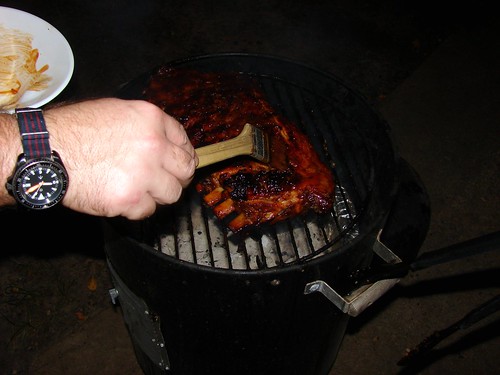
Remove the ribs from the foil and baste both sides with the sauce. Once the heat has come up, place the ribs back on the fire. You will need to stay close by, because the sauce will begin to caramelize and can burn if you’re not paying attention. Give the ribs a flip and baste. If you do this at about 5 minute intervals, you’ll be able to bake on that sauce after 2 or 3 flips. Believe me, you want to bake it on.
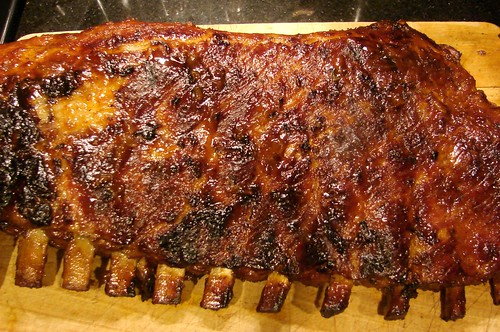
Notice how the meat has shrunken away from the bones? That’s prove positive you’re about to eat some ‘fall off the bone ribs’. Alternatively, you could cook the ribs tented in the oven for the first 90 minutes, then transfer to the grill to add some of that smokiness and char marks. This goes great with potato salad and roasted corn on the cob!
Cookingly yours,
Anamaris

































































